Bifunctional N-TiO2/C/PU Foam for Interfacial Water Evaporation and Sewage Purification
Abstract
:1. Introduction
2. Materials and Methods
2.1. Materials
2.2. Preparation of N-TiO2/C
2.3. Preparation of N-TiO2/C/PU (NTCP) Foams
2.4. Characterization
2.5. Solar Light-Driven Evaporation of Water
2.6. Photocatalytic Degradation Experiment
3. Results
3.1. Characterization of N-TiO2/C
3.2. Photothermal Conversion of N-TiO2/C
3.3. Water Evaporation Performance of NTCP
3.4. Photodegradable Organic Dye Properties of NTCP
4. Conclusions
Supplementary Materials
Author Contributions
Funding
Institutional Review Board Statement
Informed Consent Statement
Data Availability Statement
Conflicts of Interest
References
- Guo, Y.; Li, C.Q.; Wei, P.L.; Hou, K.; Zhu, M.F. Scalable carbon black deposited fabric/hydrogel composites for affordable solar-driven water purification. J. Mater. Sci. Technol. 2022, 106, 10–18. [Google Scholar] [CrossRef]
- Elimelech, M.; Phillip, W.A. The Future of Seawater Desalination: Energy, Technology, and the Environment. Science 2011, 333, 712–717. [Google Scholar] [CrossRef] [PubMed]
- Fritzmann, C.; Löwenberg, J.; Wintgens, T.; Melin, T. State-of-the-art of reverse osmosis desalination. Desalination 2007, 216, 1–76. [Google Scholar] [CrossRef]
- Burheim, O.S.; Seland, F.; Pharoah, J.G.; Kjelstrup, S. Improved electrode systems for reverse electro-dialysis and electro-dialysis. Desalination 2012, 285, 147–152. [Google Scholar] [CrossRef]
- Alarcón-Padilla, D.C.; García-Rodríguez, L. Application of absorption heat pumps to multi-effect distillation: A case study of solar desalination. Desalination 2007, 212, 294–302. [Google Scholar] [CrossRef]
- Ying, P.J.; Li, M.; Yu, F.L.; Geng, Y.; Zhang, L.Y.; He, J.J.; Zheng, Y.J.; Chen, R. Band Gap Engineering in an Efficient Solar-Driven Interfacial Evaporation System. ACS Appl. Mater. Interfaces 2020, 12, 32880–32887. [Google Scholar] [CrossRef]
- Moradi, A.; Kazemeini, M.; Hosseinpour, V.; Pourebrahimi, S. Efficient degradation of naproxen in wastewater using Ag-deposited ZnO nanoparticles anchored on a house-of-cards-like MFI-type zeolite: Preparation and physicochemical evaluations of the photocatalyst. J. Water Process Eng. 2024, 60, 105155. [Google Scholar]
- Gahrouei, A.E.; Vakili, S.; Zandifar, A.; Pourebrahimi, S. From wastewater to clean water: Recent advances on the removal of metronidazole, ciprofloxacin, and sulfamethoxazole antibiotics from water through adsorption and advanced oxidation processes (AOPs). Environ. Res. 2024, 252, 119029. [Google Scholar]
- Zhu, L.L.; Gao, M.M.; Peh, C.K.N.; Ho, G.W. Recent progress in solar-driven interfacial water evaporation: Advanced designs and applications. Nano Energy 2019, 57, 507–518. [Google Scholar] [CrossRef]
- Guo, M.Y.; Yuan, B.H.; Sui, Y.; Xiao, Y.; Dong, J.; Yang, L.X.; Bai, L.J.; Yang, H.W.; Wei, D.L.; Wang, W.X.; et al. Rational design of molybdenum sulfide/tungsten oxide solar absorber with enhanced photocatalytic degradation toward dye wastewater purification. J. Colloid Interface Sci. 2023, 631, 33–43. [Google Scholar] [CrossRef]
- Wang, R.; Deng, J.S.; Wu, P.; Ma, Q.L.; Dong, X.T.; Yu, W.S.; Liu, G.X.; Wang, J.X.; Liu, L. Sandwich-type absorber for synergistically enhanced solar water evaporation and photocatalysis. J. Environ. Chem. Eng. 2022, 10, 108173. [Google Scholar]
- Noureen, L.; Xie, Z.J.; Gao, Y.J.; Li, M.M.; Hussain, M.; Wang, K.; Zhang, L.B.; Zhu, J.T. Multifunctional Ag3PO4-rGO-Coated Textiles for Clean Water Production by Solar-Driven Evaporation, Photocatalysis, and Disinfection. ACS Appl. Mater. Interfaces 2020, 12, 6343–6350. [Google Scholar]
- Fang, W.; Chen, H.; He, X.; Li, W.X.; Zhang, W.H.; Shen, Y.; Chen, X.D.; Zhao, L. Plasmonic Au-NPs enhanced 3D biogenic foam for solar vapor generation. J. Porous Mater. 2021, 28, 1655–1666. [Google Scholar]
- Gong, L.; Sun, J.; Zheng, P.; Lin, F.; Yang, G.C.; Liu, Y.S. Two Birds One Stone: Facile and Controllable Synthesis of the Ag Quantum Dots/Reduced Graphene Oxide Composite with Significantly Improved Solar Evaporation Efficiency and Bactericidal Performance. ACS Appl. Mater. Interfaces 2021, 13, 17649–17657. [Google Scholar] [CrossRef] [PubMed]
- Ye, M.M.; Jia, J.; Wu, Z.J.; Qian, C.X.; Chen, R.; O’Brien, P.G.; Sun, W.; Dong, Y.C.; Ozin, G.A. Synthesis of Black TiOx Nanoparticles by Mg Reduction of TiO2 Nanocrystals and their Application for Solar Water Evaporation. Adv. Energy Mater. 2017, 7, 1601811. [Google Scholar]
- Wang, J.; Li, Y.Y.; Deng, L.; Wei, N.N.; Weng, Y.K.; Dong, S.; Qi, D.P.; Qiu, J.; Chen, X.D.; Wu, T. High-Performance Photothermal Conversion of Narrow-Bandgap Ti2O3 Nanoparticles. Adv. Mater. 2017, 29, 1603730. [Google Scholar]
- Yang, H.F.; Liu, Y.S.; Qiao, Z.Q.; Li, X.D.; Wang, Y.C.; Bao, H.B.; Yang, G.C.; Li, X.M. One-step ultrafast deflagration synthesis of N-doped WO2.9 nanorods for solar water evaporation. Appl. Surf. Sci. 2021, 555, 149697. [Google Scholar]
- Ibrahim, I.; Seo, D.H.; McDonagh, A.M.; Shon, H.K.; Tijing, L. Semiconductor photothermal materials enabling efficient solar steam generation toward desalination and wastewater treatment. Desalination 2021, 500, 114853. [Google Scholar]
- Zhou, Q.X.; Li, H.; Li, D.D.; Wang, B.B.; Wang, H.; Bai, J.B.; Ma, S.H.; Wang, G. A graphene assembled porous fiber-based Janus membrane for highly effective solar steam generation. J. Colloid Interface Sci. 2021, 592, 77–86. [Google Scholar] [CrossRef]
- Cong, C.; Gao, M.; Xing, G.Y.; Wu, Y.; Liu, L.; Mainul, M.; Wang, J.X.; Wang, Z. Carbon nanomaterials treated by combination of oxidation and flash for highly efficient solar water evaporation. Chemosphere 2021, 277, 130248. [Google Scholar]
- Yin, M.X.; Hsin, Y.; Guo, X.G.; Zhang, R.F.; Huang, X.; Zhang, X.Y. Facile and low-cost ceramic fiber-based carbon-carbon composite for solar evaporation. Sci. Total Environ. 2021, 759, 143546. [Google Scholar] [CrossRef]
- Li, M.L.; Wang, M.; Zhu, L.F.; Li, Y.M.; Yan, Z.; Shen, Z.Q.; Cao, X.B. Facile microwave assisted synthesis of N-rich carbon quantum dots/dual-phase TiO2 heterostructured nanocomposites with high activity in CO2 photoreduction. Appl. Catal. B-Environ. 2018, 231, 269–276. [Google Scholar] [CrossRef]
- Lou, L.H.; Kendall, R.J.; Ramkumar, S. Comparison of hydrophilic PVA/TiO2 and hydrophobic PVDF/TiO2 microfiber webs on the dye pollutant photo-catalyzation. J. Environ. Chem. Eng. 2020, 8, 103914. [Google Scholar] [CrossRef]
- Zhu, S.L.; Yu, Z.H.; Zhang, L.H.; Watanabe, S. Solution Plasma-Synthesized Black TiO2 Nanoparticles for Solar-Thermal Water Evaporation. ACS Appl. Nano Mater. 2021, 4, 3940–3948. [Google Scholar] [CrossRef]
- Wang, A.W.; Zhu, Q.; Xing, Z.P. Multifunctional quaternized chitosan@surface plasmon resonance Ag/N-TiO2 core-shell microsphere for synergistic adsorption-photothermal catalysis degradation of low-temperature wastewater and bacteriostasis under visible light. Chem. Eng. J. 2020, 393, 124781. [Google Scholar] [CrossRef]
- Bakre, P.V.; Tilve, S.G.; Shirsat, R.N. Influence of N sources on the photocatalytic activity of N-doped TiO2. Arab. J. Chem. 2020, 13, 7637–7651. [Google Scholar] [CrossRef]
- Cao, Y.Y.; Chen, D.D.; Meng, Y.; Saravanamurugan, S.; Li, H. Visible-light-driven prompt and quantitative production of lactic acid from biomass sugars over a N-TiO2 photothermal catalyst. Green Chem. 2021, 23, 10039–10049. [Google Scholar] [CrossRef]
- Zhang, Z.Z.; Luo, Z.S.; Yang, Z.P.; Zhang, S.Y.; Zhang, Y.; Zhou, Y.G.; Wang, X.X.; Fu, X.Z. Band-gap tuning of N-doped TiO2 photocatalysts for visible-light-driven selective oxidation of alcohols to aldehydes in water. RSC Adv. 2013, 3, 7215–7218. [Google Scholar] [CrossRef]
- Yu, Y.M.; Xia, J.X.; Chen, C.; Chen, H.Y.; Geng, J.F.; Li, H. One-step synthesis of a visible-light driven C@N-TiO2 porous nanocomposite: Enhanced absorption, photocatalytic and photoelectrochemical performance. J. Phys. Chem. Solids 2020, 136, 109169. [Google Scholar] [CrossRef]
- Wang, Q.Y.; Qiu, L.Y.; Jia, Y.; Chang, Y.; Tan, X.Y.; Yang, L.X.; Chen, H. Design of carbon loaded porous TiO2 foams by the hydrothermal-assisted annealing carbonization of fruit residue for solar-driven water evaporation. Sol. Energy Mater. Sol. Cells 2019, 202, 110116. [Google Scholar] [CrossRef]
- Zha, Z.J.; Wu, J.; Tong, S.P.; Cao, X.B. Photothermal-photocatalytic thin-layer flow system for synergistic treatment of wastewater. Chin. J. Chem. Eng. 2023, 63, 120–129. [Google Scholar] [CrossRef]
- Liu, X.H.; Cheng, H.Y.; Guo, Z.Z.; Zhan, Q.; Qian, J.W.; Wang, X.B. Bifunctional, Moth-Eye-Like Nanostructured Black Titania Nanocomposites for Solar-Driven Clean Water Generation. ACS Appl. Mater. Interfaces 2018, 10, 39661–39669. [Google Scholar] [PubMed]
- Zhang, X.; Cai, M.; Cui, N.X.; Chen, G.F.; Zou, G.Y.; Zhou, L. One-Step Synthesis of b-N-TiO2/C Nanocomposites with High Visible Light Photocatalytic Activity to Degrade Microcystis aeruginosa. Catalysts 2020, 10, 579. [Google Scholar] [CrossRef]
- Hu, M.Q.; Xing, Z.P.; Cao, Y.; Li, Z.Z.; Yan, X.; Xiu, Z.Y.; Zhao, T.Y.; Yang, S.L.; Zhou, W. Ti3+ self-doped mesoporous black TiO2/SiO2/g-C3N4 sheets heterojunctions as remarkable visible-lightdriven photocatalysts. Appl. Catal. B-Environ. 2018, 226, 499–508. [Google Scholar] [CrossRef]
- Anitha, B.; Khadar, M.A. Anatase-rutile phase transformation and photocatalysis in peroxide gel route prepared TiO2 nanocrystals: Role of defect states. Solid State Sci. 2020, 108, 106392. [Google Scholar] [CrossRef]
- Yuan, W.J.; Li, J.C.; Wang, L.K.; Chen, P.; Xie, A.J.; Shen, Y.H. Nanocomposite of N-Doped TiO2 Nanorods and Graphene as an Effective Electrocatalyst for the Oxygen Reduction Reaction. ACS Appl. Mater. Interfaces 2014, 6, 21978–21985. [Google Scholar] [PubMed]
- Frolova, L.V.; Magedov, I.V.; Harper, A.; Jha, S.K.; Ovezmyradov, M.; Chandler, G.; Garcia, J.; Bethke, D.; Shaner, E.A.; Vasiliev, I.; et al. Tetracyanoethylene oxide-functionalized graphene and graphite characterized by Raman and Auger spectroscopy. Carbon 2015, 81, 216–222. [Google Scholar]
- Wang, W.S.; Li, D.Y.; Zuo, S.Y.; Guan, Z.Y.; Xu, H.M.; Ding, S.; Xia, D.S. Discarded-leaves derived biochar for highly efficient solar water evaporation and clean water production: The crucial roles of graphitized carbon. Colloids Surf. A Physicochem. Eng. Asp. 2022, 639, 128337. [Google Scholar]
- Guo, J.; Wang, J.K.; Jiang, X.D. Preparation of N-TiO2 photocatalyst by sol-gel method and its photodegradation of ionic dyes under sunlight. Desalin. Water Treat. 2021, 237, 292–301. [Google Scholar]
- Wang, R.K.; Ma, X.Q.; Hao, K.; Song, L.; Liu, T.; Dai, P.F.; Li, Y.C.; Tjong, S.C.; Yu, Q.; Wang, Z.W. Facile synthesis of C, N-TiO2 nanorods via layered Ti3O72--TMAH interlaminar bonding interaction and their enhanced catalytic performance. Mater. Res. Express 2020, 7, 025022. [Google Scholar]
- Qu, L.L.; Huang, D.L.; Shi, H.F.; Gu, M.B.; Li, J.L.; Dong, F.; Luo, Z.J. TiO2/carboxylate-rich porous carbon: A highly efficient visible-light-driven photocatalyst based on the ligand-to-metal charge transfer (LMCT) process. J. Phys. Chem. Solids 2015, 85, 173–179. [Google Scholar] [CrossRef]
- Zhu, Y.F.; Zhang, L.; Gao, C.; Cao, L.L. The synthesis of nanosized TiO2 powder using a sol-gel method with TiCl4 as a precursor. J. Mater. Sci. 2000, 35, 4049–4054. [Google Scholar] [CrossRef]
- Ahuja, I.S.; Singh, R.; Yadava, C.L. Structural information on cobalt(II), nickel(II), copper(II), zinc(II), silver(I) and cadmium(II) nitrate complexes with hexamethylenetetramine from their magnetic moments, electronic and infrared spectra. J. Mol. Struct. 1980, 68, 333–339. [Google Scholar] [CrossRef]
- Liu, S.T.; Zhou, J.S.; Song, H.H. Tailoring Highly N-Doped Carbon Materials from Hexamine-Based MOFs: Superior Performance and New Insight into the Roles of N Configurations in Na-Ion Storage. Small 2018, 14, 1703548. [Google Scholar] [CrossRef] [PubMed]
- Yang, K.S.; Dai, Y.; Huang, B.B. Study of the Nitrogen concentration influence on N-Doped TiO2 Anatase from First-Principles Calculations. J. Phys. Chem. C 2007, 32, 12086–12090. [Google Scholar] [CrossRef]
- Zhang, T.X.; Jiao, S.K.; Zhao, J.X.; Gao, G.R.; Yang, Y.Y.; Guo, C.L. Solar water evaporation using porous cellulose polyacrylamide hydrogel with carbon-based material containing copper oxide prepared from after-use adsorbent. Desalination 2022, 527, 115576. [Google Scholar] [CrossRef]
- Farid, M.U.; Kharraz, J.A.; Wang, P.; An, A.K. High-efficiency solar-driven water desalination using a thermally isolated plasmonic membrane. J. Clean. Prod. 2020, 271, 122684. [Google Scholar] [CrossRef]
- Wang, Q.M.; Jia, F.F.; Huang, A.H.; Qin, Y.; Song, S.X.; Li, Y.M.; Arroyo, M.A.C. MoS2@sponge with double layer structure for high-efficiency solar desalination. Desalination 2020, 481, 114359. [Google Scholar] [CrossRef]
- Han, J.; Xing, W.Q.; Yan, J.; Wen, J.; Liu, Y.T.; Wang, Y.Q.; Wu, Z.F.; Tang, L.C.; Gao, J.F. Stretchable and Superhydrophilic Polyaniline/Halloysite Decorated Nanofiber Composite Evaporator for High Efficiency Seawater Desalination. Adv. Fiber Mater. 2022, 4, 1233–1245. [Google Scholar] [CrossRef]
- Wang, S.; Niu, Y.; Yan, L.J.; Chan, W.J.; Zhu, Z.Q.; Sun, H.X.; Li, J.Y.; Liang, W.D.; Li, A. Polyimide-based superhydrophilic porous membrane with enhanced thermal insulation for efficient interfacial solar evaporation. Compos. Sci. Technol. 2022, 228, 109683. [Google Scholar] [CrossRef]
- Wu, C.M.; Cheng, C.T.; Tessema, A.A.; Motora, K.G.; Rani, G.M. Staple carbon fabric/polyurethane Janus membranes for photothermal conversion and interfacial steam generation. J. Polym. Res. 2023, 30, 196. [Google Scholar]
- Xi, Y.B.; Guo, W.Q.; Wang, X.J.; Lin, X.L.; Lyu, G.J. Photothermal Properties and Solar Water Evaporation Performance of Lignin-Based Polyurethane Foam Composites. Langmuir 2024, 40, 7205–7214. [Google Scholar] [PubMed]
- Zhao, Y.N.; Liu, Z.X.; Yu, L.; Zhang, J.R.; Wu, F.; Lv, T.T.; Zhao, C.; Xing, G.J. Self-floating and long-term stable Ti3C2Tx/polyurethane composite membranes with highly efficient photothermal conversion performances for multiple applications. Desalination 2024, 583, 117720. [Google Scholar] [CrossRef]
- Hao, D.D.; Yang, Y.D.; Xu, B.; Cai, Z.S. Bifunctional Fabric with Photothermal Effect and Photocatalysis for Highly Efficient Clean Water Generation. ACS Sustain. Chem. Eng. 2018, 6, 10789–10797. [Google Scholar]
- Su, L.F.; Liu, X.Y.; Xia, W.; Wu, B.; Li, C.J.; Xu, B.; Yang, B.; Xia, R.; Zhou, J.H.; Qian, J.S.; et al. Simultaneous photothermal and photocatalytic MOF-derived C/TiO2 composites for high-efficiency solar driven purification of sewage. J. Colloid Interface Sci. 2023, 650, 613–621. [Google Scholar] [CrossRef]
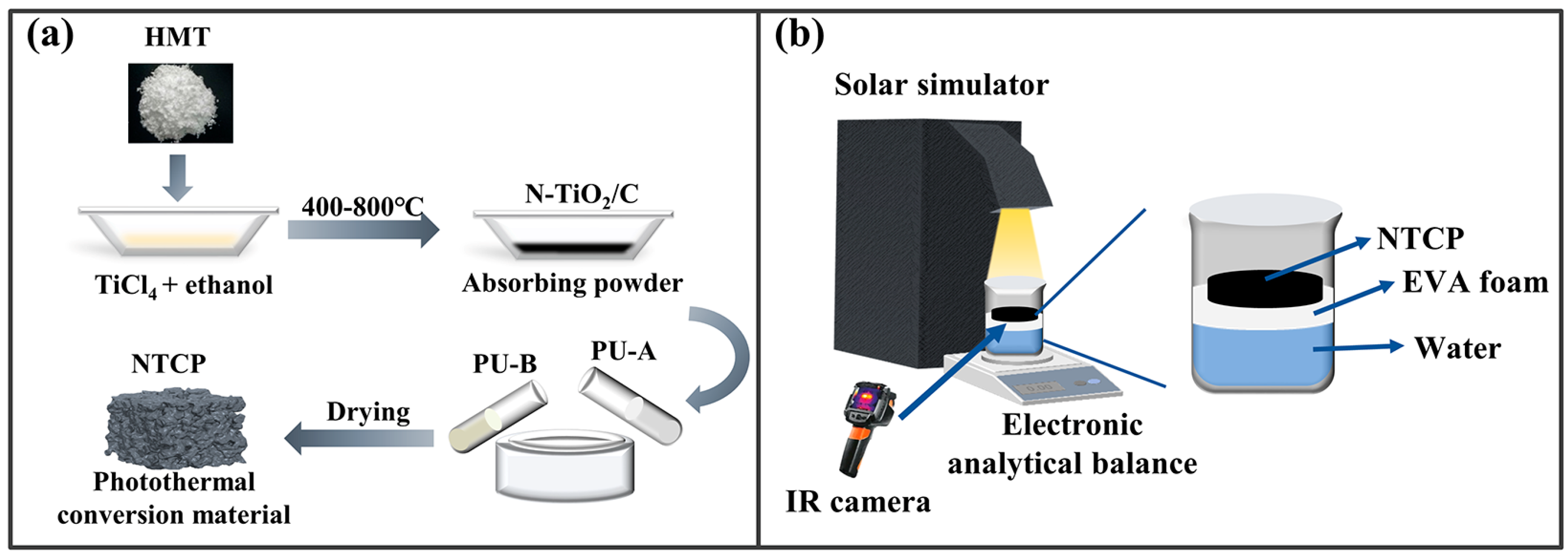

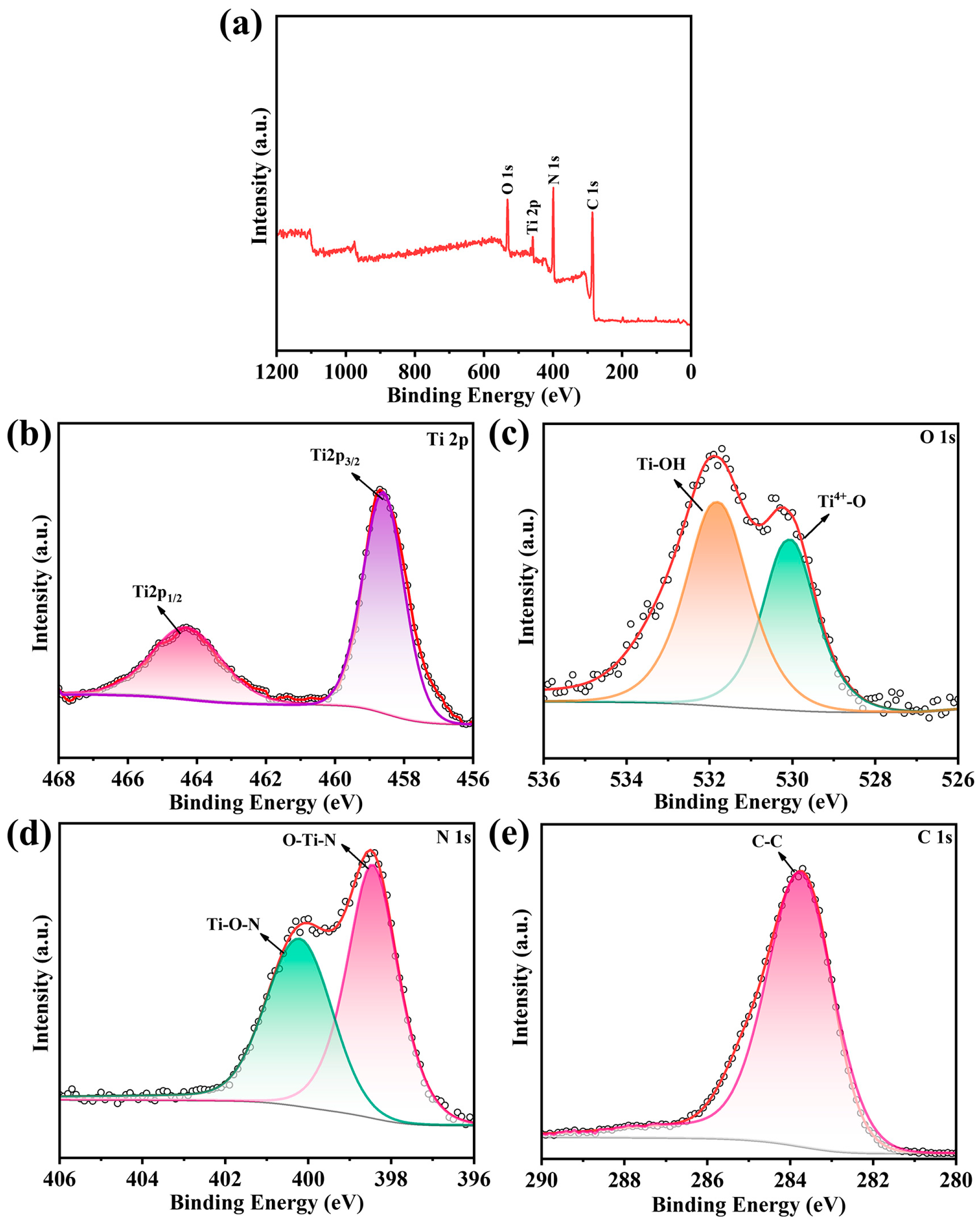

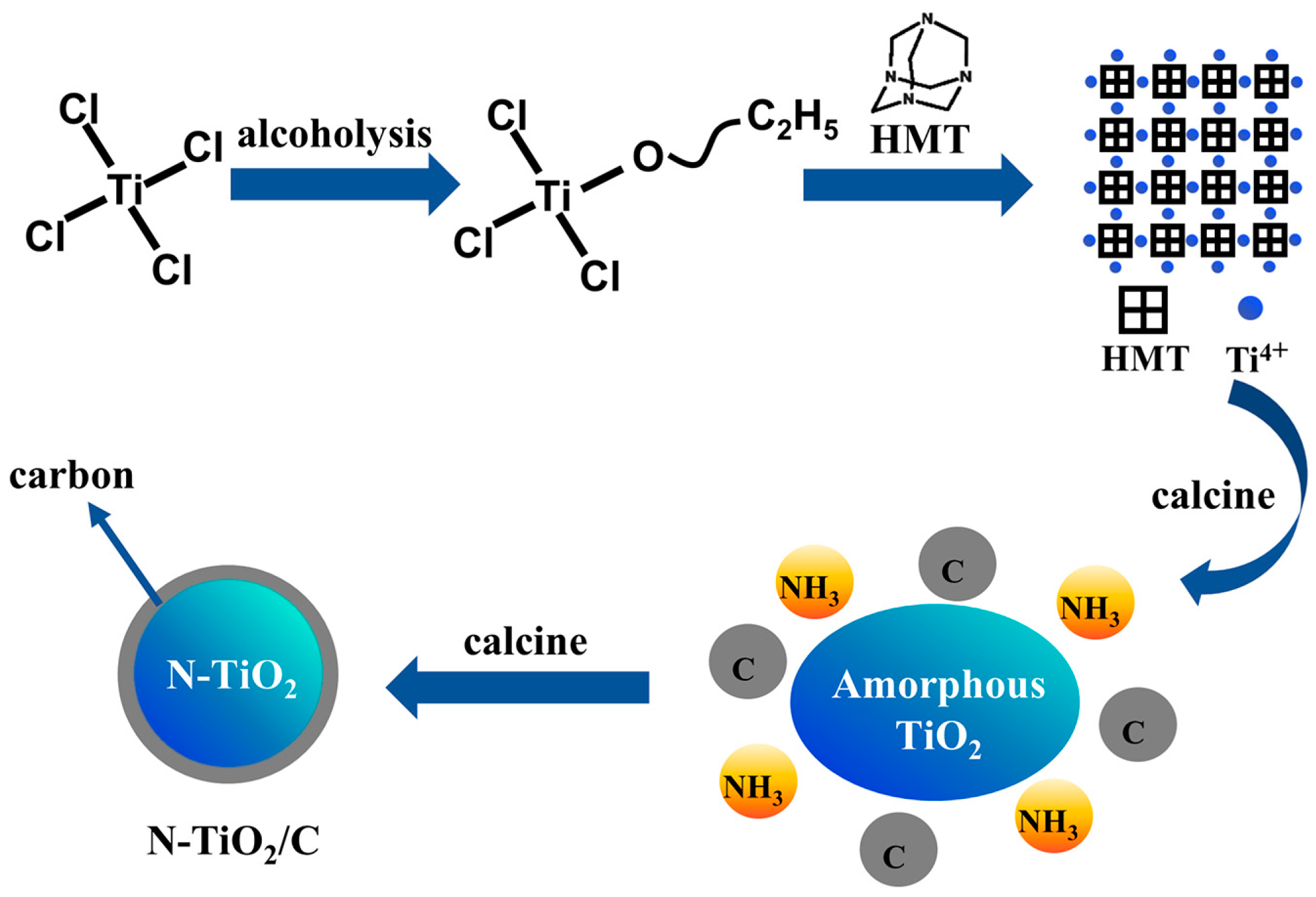
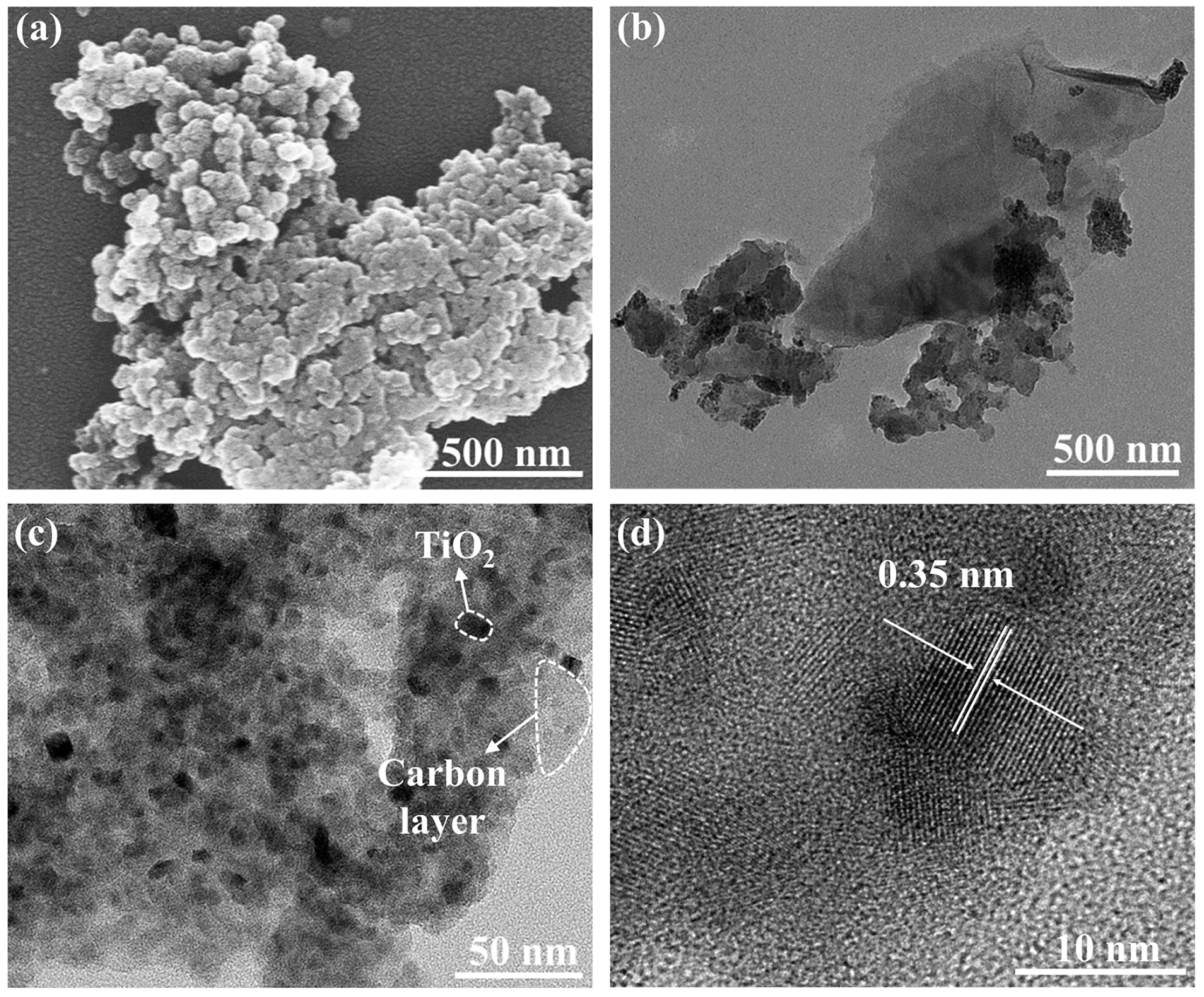

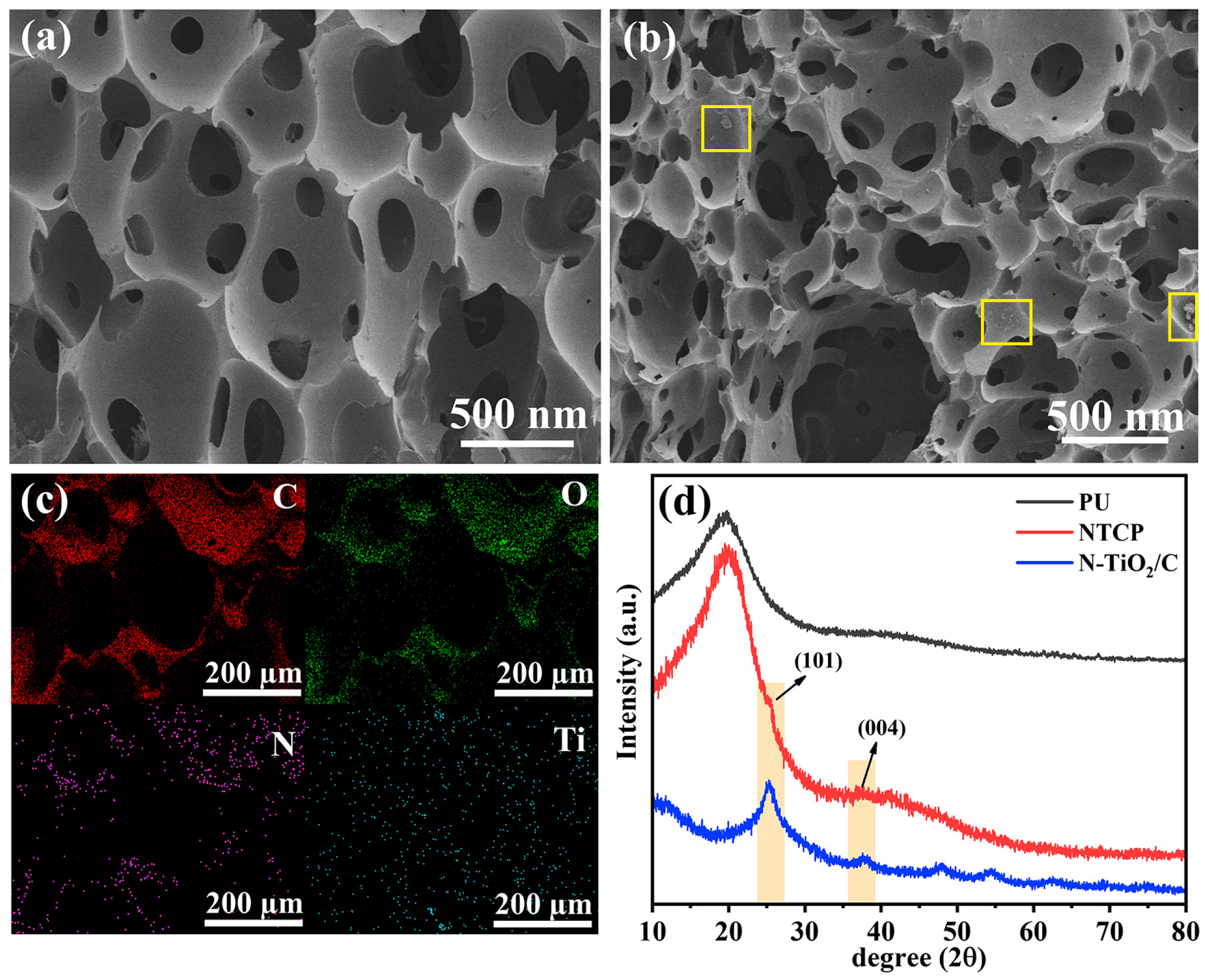
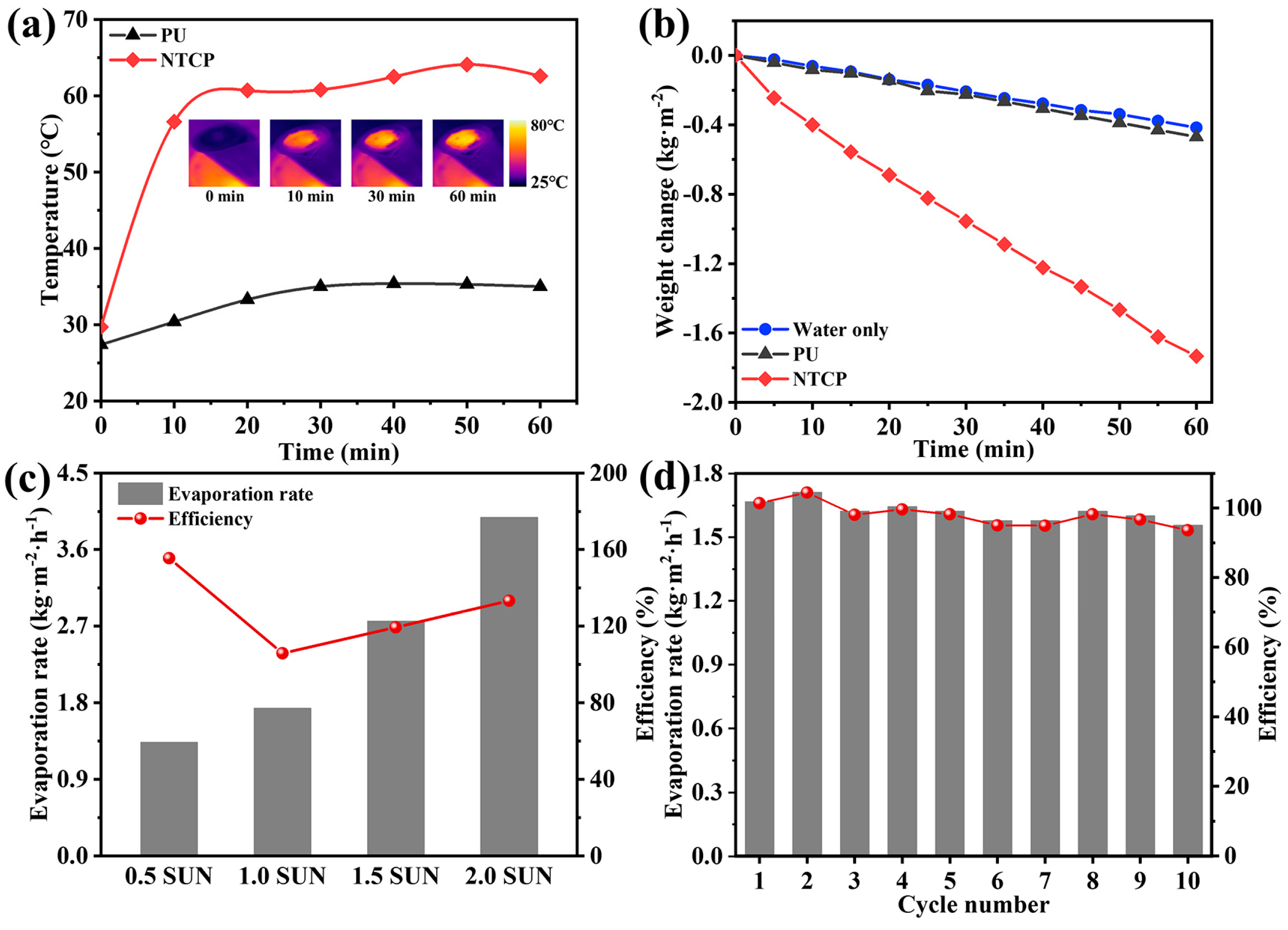
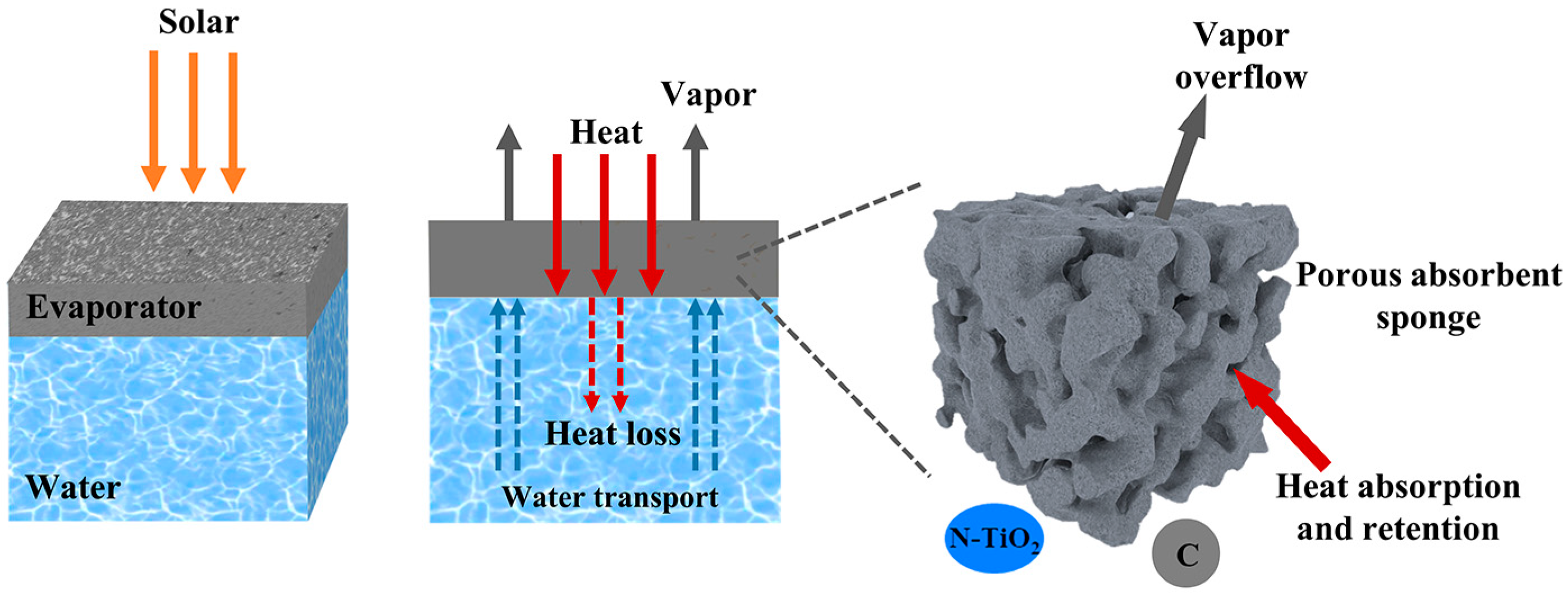


Disclaimer/Publisher’s Note: The statements, opinions and data contained in all publications are solely those of the individual author(s) and contributor(s) and not of MDPI and/or the editor(s). MDPI and/or the editor(s) disclaim responsibility for any injury to people or property resulting from any ideas, methods, instructions or products referred to in the content. |
© 2025 by the authors. Licensee MDPI, Basel, Switzerland. This article is an open access article distributed under the terms and conditions of the Creative Commons Attribution (CC BY) license (https://creativecommons.org/licenses/by/4.0/).
Share and Cite
Wang, K.; Li, W.; Long, Y. Bifunctional N-TiO2/C/PU Foam for Interfacial Water Evaporation and Sewage Purification. Materials 2025, 18, 1550. https://doi.org/10.3390/ma18071550
Wang K, Li W, Long Y. Bifunctional N-TiO2/C/PU Foam for Interfacial Water Evaporation and Sewage Purification. Materials. 2025; 18(7):1550. https://doi.org/10.3390/ma18071550
Chicago/Turabian StyleWang, Ke, Weifeng Li, and Yumei Long. 2025. "Bifunctional N-TiO2/C/PU Foam for Interfacial Water Evaporation and Sewage Purification" Materials 18, no. 7: 1550. https://doi.org/10.3390/ma18071550
APA StyleWang, K., Li, W., & Long, Y. (2025). Bifunctional N-TiO2/C/PU Foam for Interfacial Water Evaporation and Sewage Purification. Materials, 18(7), 1550. https://doi.org/10.3390/ma18071550





